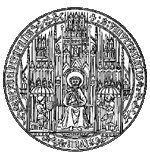
| |
Doctoral Programme 'Molecular Cell Biology' (GK 230)
1. Programme and objectives
1.1 Summary
The doctoral programme GK 230 "Molecular and Cell Biology" offers its research fellows a wide range of study and research opportunities in the field of molecular and cellular biology. It focuses on the analysis of molecular mechanisms and their integration into the whole cell function. Investigating the complex functions of the cell requires a multitude of techniques and methods. In vitro systems are developed and employed to identify and characterise the molecules which are involved in these functions. Genetic modification of cells allows the analysis of cellular functions in relation to both, the cell as a whole and the organism.
Special topics are: protein synthesis, folding, transport and degradation, as well as organelle biogenesis, cell polarity, cell-to-cell interaction.
The doctoral programme GK 230 offers its research fellows a carefully designed study programme. Topic-based seminars discuss and elucidate various research questions of cell biology. Method courses as well as external and internal academic advising are also part of the curriculum.
The doctoral program is complemented by the international "Molecular and Cellular Biology" (MCB) Master`s programme. The doctoral programme GK 230 closely cooperates with the Sonderforschungsbereich 352, a DFG sponsored priority programme focussing on molecular mechanisms of intracellular transport processes.
1.2 Research Programme
The research programme covers a wide range of molecular cell biology topics:
Transport between the nucleus and the cytoplasm
Molecules constantly travel between the nucleus and the cytoplasm: RNA and RNP molecules are exported from the nucleus to the cytoplasm, on the one hand, and proteins are imported from the cytoplasm to the nucleus, on the other hand. Combining genetic and biochemical methods, Ed Hurt and Dirk Görlich, with their respective working groups, have dedicated themselves to exploring the molecular mechanisms responsible for transport from the nucleus to the cytoplasm and vice versa. They employ a multitude of methods: genetic and biochemical approaches, microscopy and biophysics, as well as computer simulation.
Lamins form a complex network in the interior of the nucleus, which is linked to the nuclear membrane and the chromatin. Harald Herrmann-Lerdon characterises structure-defining elements of lamins by using microscopy and biochemical methods.mRNA transport and protein localisation
mRNA localisation allows proteins to be asymmetrically distributed within the cell. The mechanisms at work in these transport processes are investigated by Ralf-Peter Jansen and Matthias Seedorf, who use yeast as an experimental system. Protein stability and transport to the nucleus are decisive factors in setting biological clocks. Michael Brunner examines intracellular transport regulation of FRQ frequency protein, a central regulator of neurospora crassa`s biological clock.Signal sequence-dependend protein localisation
Secreted and membrane proteins are inserted into the membrane of the endoplasmaic reticulum (ER). This process involves signal sequences, the signal recognition particle (SRP), the SRP receptor and a translocation channel (translocon) in the ER membrane. Irmgard Sinning and Bernhard Dobberstein characterise structural and functional aspects of SRP-regulated translocation of proteins in E. coli and animal cells.Vesicular transport
Different aspects of vesicular transport are the main focus of six research groups. The group of Felix Wieland studies anterograde and retrograde trafficking between ER and Golgi membranes, with special emphasis on the molecular mechanisms of vesicle budding reactions. David Robinson analyses Golgi vesicles that carry proteins, either to lysosomes, or vacuoles in plamt cells. Marie Isabel Geli investigates the role of the myosin-1 motor in yeast endocytosis. A new test system was developed which allows the identification of factors which interact with myosin-1.
The amyloid precursor protein (APP) is proteolytically processed by various secretases during its intracellular transport. Gerhard Multhaup`s research objective is to find out how copper ions affect the ß-secretase activity and amyloid production.
Vesicular transport is regulated by different signals. Peter Mayinger examines the function of phosphoinositides in the regulation of intracellular protein transport and ATP transport into the ER lumen. Blanche Schwappach studies how transport of ion channels to the plasma membrane is regulated. She employs a random screen based on retroviral gene transfer and flow cytometry. Walter Nickel uses a similar approach to identify the molecular mechanisms for unconventional secretion of particular growth factors, i. e. fibroplast growth factor, migration inhibiting factor.
The biosynthetic origin of peroxisomes is under intensive investigation. After maturation, additional proteins are imported from the cytosol to peroxisomal precursor organelles. Wilhelm Just and his working group characterise stages in peroxisomal biogenesis and the impact of the cytoskeleton peroxisomal mobility.
